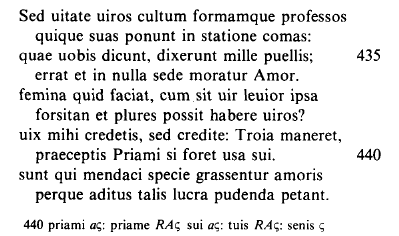No CrossRef data available.
Article contents
Ovid, Ars Amatoria III. 433–42
Published online by Cambridge University Press: 28 February 2013
Extract

Ovid has advised his female audience to appear often in public, and to let pass no occasion for attracting admirers; now he warns that not every man who shows interest in them can be trusted. Critics have so far concerned themselves only with 439-40, and the problems of this couplet have been essentially solved. Goold's Priamo…satae is as neat a way as one could wish to introduce a reference to Cassandra, who must be the exemplar of unheeded advice to whom Ovid is alluding. The connection of these lines to their context – a question that perplexed Brandt – is also clear: they are an ironically portentous build-up to the next revelation (sunt qui mendaci specie grassentur amoris etc.).
- Type
- Research Article
- Information
- Copyright
- Copyright © The Author(s). Published online by Cambridge University Press 1980
References
NOTES
1. HSCP 69 (1965) 85–7Google Scholar.
2. Cf., e.g., Met. 1.627, 9.34, F. 2.66, 674.
3. This problem does not arise in, e.g., Ars 2. 18-20, where the inconstancy of Amor adds to the challenge Ovid faces in writing an Ars Amatoria.
4. Bömer ad. loc. wrongly disputes the relevance of Ovid's words to Maiestas Iouis, for which cf. Germ, . Arat. 186Google Scholar and cp. Fasti 5.45 assidet inde Ioui, Iouis est fidissima custos/et praestat sine ui sceptra tenenda Ioui (cf. Met. 2.847 sceptri grauitate relicta).
5. The writer of the Epistula Sapphus (not Ovid, as I have argued in a paper forthcoming in HSCP) echoes 435: nec uos decipiant blandae mendacia linguae: / quae uobis dicit, dixerat ante mihi(55(.). This does not necessarily mean that the author of the ES read the line in his text of the Ars, only that the lines were in existence by the time of Nero, the approximate date of the ES.
6. Ovid might also have made more graceful use of habere in the sense ‘enjoy sexual relations with’, cp. Am. 3.12.6 cum multis uereor ne sit habenda mihi.
7. Cf. Med. fac. 25f. feminea uestri poliuntur lege mariti, / et uix ad cultus nupta, quod addat, habet.
8. This conclusion obviously rests on my belief that 435f. are spurious. If this is not accepted, several of the difficulties observed in the passage could be removed or diluted by the following rearrangement and repunctuation:

Alternatively, as Professor Kenney points out to me, 435f. could be transposed to follow 454.
9. I have argued elsewhere (above, n. 5) that the references to a letter of Sappho in Am. 2.18.26 and 34 are interpolations which have replaced references to genuine letters. In Met. 7.687f. an interpolation designed to introduce an element of the myth of Cephalus and Procris rejected by Ovid has caused the loss of at least half a line.
10. Insertion of marginal parallels is easily detected when the source of the parallel is the same work (e.g., Prop. 1.2.1-2 repeated after 4.5.54) or another extant work (e.g. Soph. Ant. 277 added after Aesch, . Pe. 253Google Scholar); when the source is a lost work, the result is an apparently motiveless interpolation. See Fraenkel, E. on Aesch. Ag. 525ff., 570ff, 899ff.Google Scholar, Eranos 44 (1946) 83ffGoogle Scholar. In the case of Ars 3.433ff. the lost couplet might even have begun with sed uitate uiros or similar words.
11. I regret that for several reasons I cannot accept the ingenious suggestion of my colleague Anna Maria Dabrowski (published with warm commendation by Goold 92f.) that 2.669-74 form the peroration of the Ars and are to be placed between 2.732 and 733. (1) The addressee of tolerate (669) would naturally be taken as the same as that of properate (727), i.e., the pair of lovers at 703-32; not until 733 would the true addressee, grata iuuentus, be clear. (2) The twist in the meaning of quaerit opes in 674 (‘requires riches’ as in Cic., Parad. 44Google Scholartot dotes magnam quaerunt pecuniam. Ovid Ars 3.527 formosae non artis opem praeceptaque quaerunt, rather than ‘seeks riches’ as the analogy with seafaring leads one to expect) is clever in itself, but out of place in a conclusion: Ovid does not cut the ground from under his feet so blatantly. (3) Ovid does not elsewhere speak of his audience as themselves being farmers or sailors, but instead uses these respectable artes to illustrate his own; he does this most effectively at 731f. totis incumbere remis / utile et admisso subdere calcar equo. to conclude the description of lovemaking that is the true peroration of the Ars.
12. I am grateful to Elaine Fantham and E. J. Kenney for helpful comments.




